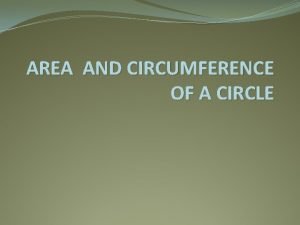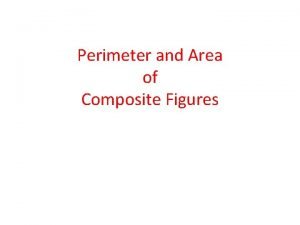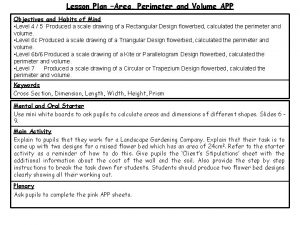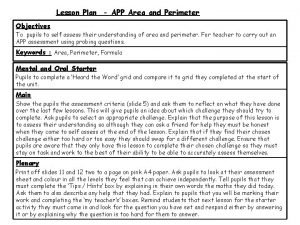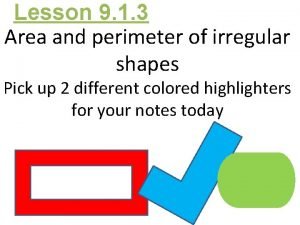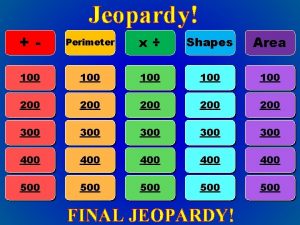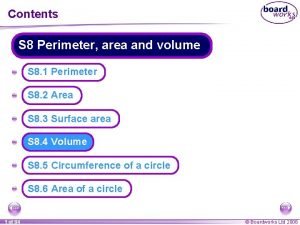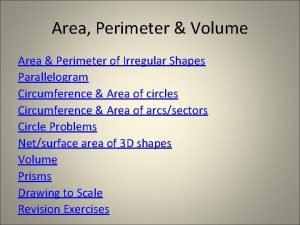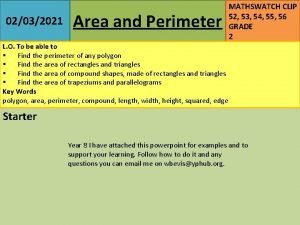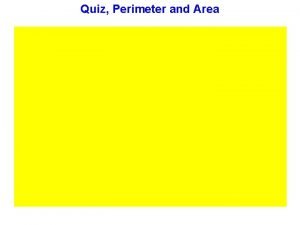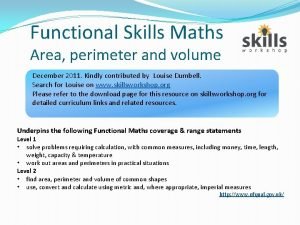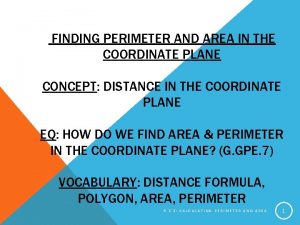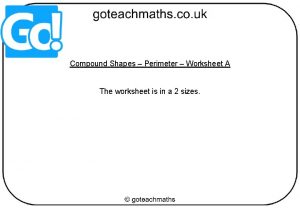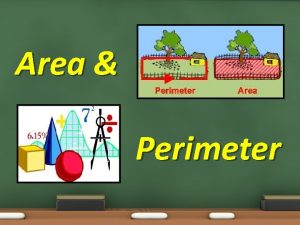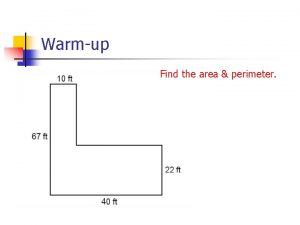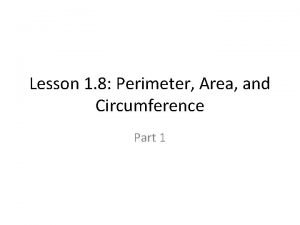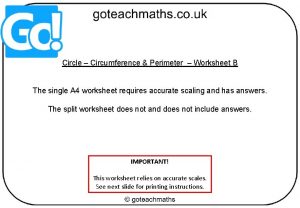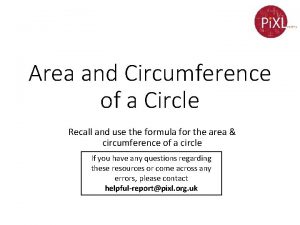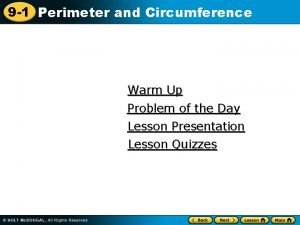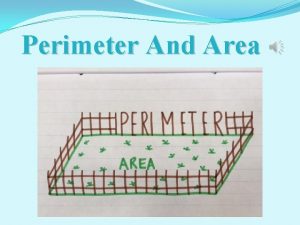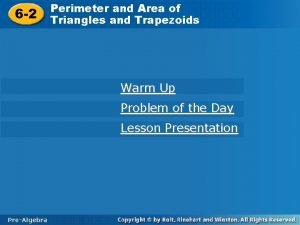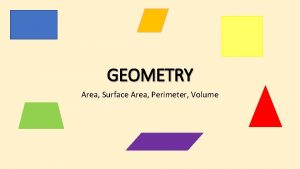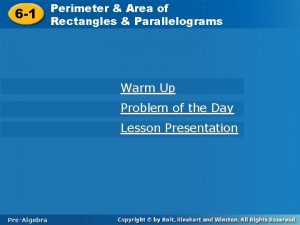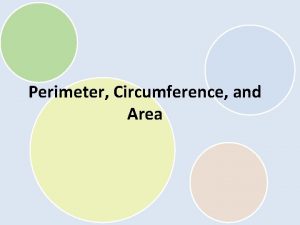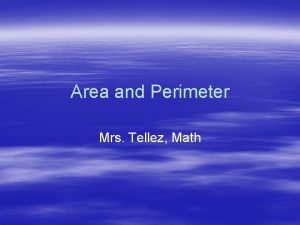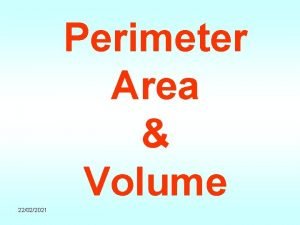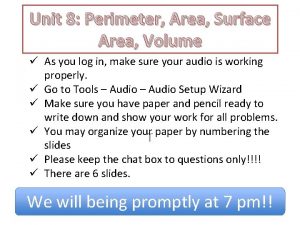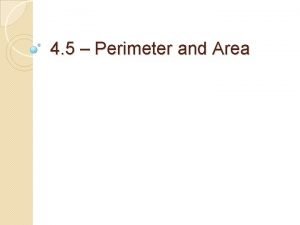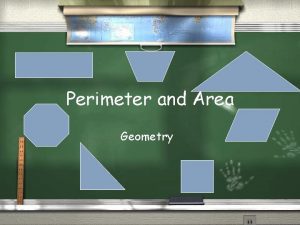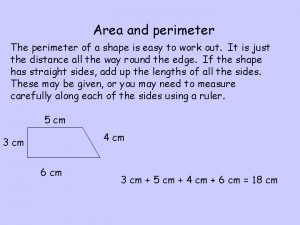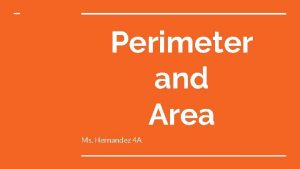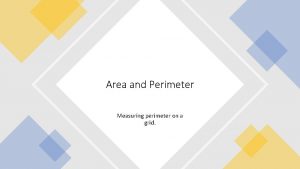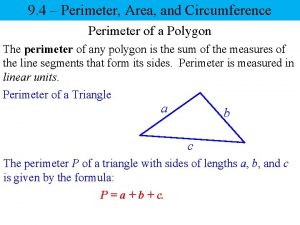Contents S 8 Perimeter area and volume A






















- Slides: 22

Contents S 8 Perimeter, area and volume A S 8. 1 Perimeter A S 8. 2 Area A S 8. 3 Surface area A S 8. 4 Volume A S 8. 5 Circumference of a circle A S 8. 6 Area of a circle 1 of 84 © Boardworks Ltd 2006

Making cuboids The following cuboid is made out of interlocking cubes. How many cubes does it contain? 2 of 84 © Boardworks Ltd 2006

Making cuboids We can work this out by dividing the cuboid into layers. The number of cubes in each layer can be found by multiplying the number of cubes along the length by the number of cubes along the width. 3 × 4 = 12 cubes in each layer. There are three layers altogether so the total number of cubes in the cuboid = 3 × 12 = 36 cubes. 3 of 84 © Boardworks Ltd 2006

Making cuboids The amount of space that a three-dimensional object takes up is called its volume. Volume is measured in cubic units. We can use mm 3, cm 3, m 3 or km 3. The 3 tells us that there are three dimensions, length, width and height. Liquid volume or capacity is measured in ml, l, pints or gallons. 4 of 84 © Boardworks Ltd 2006

Volume of a cuboid We can find the volume of a cuboid by multiplying the area of the base by the height. The area of the base = length × width So: height, h Volume of a cuboid = length × width × height width, w 5 of 84 length, l = lwh © Boardworks Ltd 2006

Volume of a cuboid What is the volume of this cuboid? Volume of cuboid = length × width × height 5 cm = 13 × 8 × 5 8 cm 6 of 84 13 cm = 520 cm 3 © Boardworks Ltd 2006

Volume of a prism made from cuboids What is the volume of this L-shaped prism? 3 cm We can think of the shape as two cuboids joined together. 3 cm 4 cm Volume of the green cuboid = 6 × 3 = 54 cm 3 6 cm Volume of the blue cuboid = 3 × 2 = 12 cm 3 Total volume 5 cm 7 of 84 = 54 + 12 = 66 cm 3 © Boardworks Ltd 2006

Volume of a prism Remember, a prism is a 3 -D shape with the same cross-section throughout its length. 3 cm We can think of this prism as lots of L-shaped surfaces running along the length of the shape. Volume of a prism = area of cross-section × length If the cross-section has an area of 22 cm 2 and the length is 3 cm: Volume of L-shaped prism = 22 × 3 = 66 cm 3 8 of 84 © Boardworks Ltd 2006

Volume of a prism What is the volume of this triangular prism? 7. 2 cm 4 cm 5 cm Area of cross-section = ½ × 5 × 4 = 10 cm 2 Volume of prism = 10 × 7. 2 = 72 cm 3 9 of 84 © Boardworks Ltd 2006

Volume of a prism What is the volume of this prism? 12 m 7 m 4 m 3 m 5 m Area of cross-section = 7 × 12 – 4 × 3 = 84 – 12 = 72 m 2 Volume of prism = 5 × 72 = 360 m 3 10 of 84 © Boardworks Ltd 2006

Contents S 8 Perimeter, area and volume A S 8. 1 Perimeter A S 8. 2 Area A S 8. 3 Surface area A S 8. 4 Volume A S 8. 5 Circumference of a circle A S 8. 6 Area of a circle 11 of 84 © Boardworks Ltd 2006

Surface area of a cuboid To find the surface area of a shape, we calculate the total area of all of the faces. A cuboid has 6 faces. The top and the bottom of the cuboid have the same area. 12 of 84 © Boardworks Ltd 2006

Surface area of a cuboid To find the surface area of a shape, we calculate the total area of all of the faces. A cuboid has 6 faces. The front and the back of the cuboid have the same area. 13 of 84 © Boardworks Ltd 2006

Surface area of a cuboid To find the surface area of a shape, we calculate the total area of all of the faces. A cuboid has 6 faces. The left hand side and the right hand side of the cuboid have the same area. 14 of 84 © Boardworks Ltd 2006

Surface area of a cuboid To find the surface area of a shape, we calculate the total area of all of the faces. Can you work out the surface 5 cm area of this cuboid? 8 cm The area of the top = 8 × 5 = 40 cm 2 7 cm The area of the front = 7 × 5 = 35 cm 2 The area of the side = 7 × 8 = 56 cm 2 15 of 84 © Boardworks Ltd 2006

Surface area of a cuboid To find the surface area of a shape, we calculate the total area of all of the faces. 8 cm 5 cm So the total surface area = 2 × 40 cm 2 7 cm Top and bottom + 2 × 35 cm 2 Front and back + 2 × 56 cm 2 Left and right side = 80 + 70 + 112 = 262 cm 2 16 of 84 © Boardworks Ltd 2006

Formula for the surface area of a cuboid We can find the formula for the surface area of a cuboid as follows. Surface area of a cuboid = l h w 2 × lw Top and bottom + 2 × hw Front and back + 2 × lh Left and right side = 2 lw + 2 hw + 2 lh 17 of 84 © Boardworks Ltd 2006

Surface area of a cube How can we find the surface area of a cube of length x? All six faces of a cube have the same area. The area of each face is x × x = x 2. Therefore: x 18 of 84 Surface area of a cube = 6 x 2 © Boardworks Ltd 2006

Chequered cuboid problem This cuboid is made from alternate purple and green centimetre cubes. What is its surface area? Surface area =2× 3× 4+2× 3× 5+2× 4× 5 = 24 + 30 + 40 = 94 cm 2 How much of the surface area is green? 47 cm 2 19 of 84 © Boardworks Ltd 2006

Surface area of a prism What is the surface area of this L-shaped prism? 3 cm 4 cm 6 cm To find the surface area of this shape we need to add together the area of the two L-shapes and the area of the six rectangles that make up the surface of the shape. Total surface area 5 cm 20 of 84 = 2 × 22 + 18 + 9 + 12 + 6 + 15 = 110 cm 2 © Boardworks Ltd 2006

Using nets to find surface area It can be helpful to use the net of a 3 -D shape to calculate its surface area. Here is the net of a 3 cm by 5 cm by 6 cm cuboid. 6 cm 3 cm 18 cm 2 3 cm 5 cm 15 cm 2 30 cm 2 15 cm 2 3 cm 18 cm 2 3 cm 21 of 84 6 cm 30 cm 2 Write down the area of each face. Then add the areas together to find the surface area. Surface Area = 126 cm 2 © Boardworks Ltd 2006

Using nets to find surface area Here is the net of a regular tetrahedron. What is its surface area? Area of each face = ½bh = ½ × 6 × 5. 2 = 15. 6 cm 2 5. 2 cm Surface area = 4 × 15. 6 = 62. 4 cm 2 6 cm 22 of 84 © Boardworks Ltd 2006
 Volume and surface area jeopardy
Volume and surface area jeopardy Circumference of a quadrant formula
Circumference of a quadrant formula Area of a figure
Area of a figure Lesson plan on area and perimeter
Lesson plan on area and perimeter Perimeter objectives
Perimeter objectives Area and perimeter grade 9
Area and perimeter grade 9 Jeopardy area and perimeter
Jeopardy area and perimeter Width definition
Width definition Volume of a cuboid formula
Volume of a cuboid formula Area and perimeter of a circle
Area and perimeter of a circle Irregular shapes area and perimeter
Irregular shapes area and perimeter Find the area of the shape below mathswatch
Find the area of the shape below mathswatch Quiz 1 perimeter and area
Quiz 1 perimeter and area Functional skills maths level 1 area and perimeter
Functional skills maths level 1 area and perimeter Area and perimeter on the coordinate plane
Area and perimeter on the coordinate plane How to find perimeter of compound shapes
How to find perimeter of compound shapes Area and perimeter objectives
Area and perimeter objectives Area and perimeter warm up
Area and perimeter warm up 1-8 practice perimeter circumference and area
1-8 practice perimeter circumference and area Perimeter circumference and area worksheet
Perimeter circumference and area worksheet Area and perimeter gcse exam questions higher
Area and perimeter gcse exam questions higher Circle recall
Circle recall Practice 1-9 perimeter circumference and area
Practice 1-9 perimeter circumference and area

